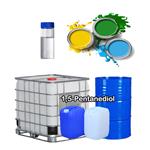Chemical Properties
1,5-Pentanediol (PDO) is a colorless, oily liquid with characteristic odor. It is miscible in water and organic solvents. It is obtained after treatment of the mixture of products resulting from the oxidation of cyclohexane with air. PDO is a building block for saturated polyesters, unsaturated polyesters and polyurethanes, solvent for inkjet ink formulations. It's suitable for polyesters for solvent-borne paints (stoving enamels, two-components paints, can & coil coatings), polyester plasticizers and for soft segments for polyurethanes.
Uses
1,5-Pentanediol has a wide range of applications. Intermediate finds applications in Initial product for chemical syntheses, Inks and coatings, Plasticizers and Solvent, Industrial chemicals.
- 1,5-Pentanediol is used as a plasticizer in cellulose products and adhesives.
- It is used as a brake fluid additive.
- It reacts with 3,4-dihydro-2H-pyran to get 5-tetrahydropyran-2-yloxy-pentan-1-ol.
- It is also used to prepare polyesters for emulsifying agents and resin intermediates.
- it is used in ink, toner and colorant products. In addition to this, it is used in brake fluid compositions.
- 1,5-Pentanediol is used to produce materials made of polyester or polyurethane, for the manufacturing of monomers, for the manufacture of polyester polyols, polycarbonatedioles and acrylic monomers, for the production of delta valerolactone and for molecules that act as reactive diluents, for the production of halogenated substances and for the production of adhesives, putties and sealing compounds, cleaners and auxiliary agents.
- used in the processes to produce hydrogen, hydrogen peroxide, sodium perborate and peroxyacetic acid and as an intermediate for pharmaceutical products.
- It is used as an ingredient for the production of polymeric thickeners, plasticizers for polyvinyl chloride, sizing agents, surfactants, for starches and chemically modified starch for application in the paper, textile and food industry, for personal hygiene products like shampoo, creams, and for paints.
Health Hazard
1,5-Pentanediol has no marked health hazard properties. Its acute toxicity is very low via all routes of exposure tested (oral, skin and inhalation). It has no irritation or sensitization effects. Limited repeated dose and long term health or reproductive effects has been generated with itself. More extensive data is available for the analogous substance 1,5-Hexanediol. Based on the total amount of information available It is not expected to cause repeated dose or long term health effects. The physical properties of 1,5-Pentanediol give no rise to concern. Its flammability is low. Therefore, It has a very low overall human health hazard potential.
Chemical Properties
clear colorless oily liquid
Uses
1,5-Pentanediol is used as a reagent in the total synthesis of (+)-Rubriflordilactone A, a nortriterpenoid natural product. 1,5-Pentanediol is also the starting material in the synthesis of Pseudomonic Acid D Sodium (P839520); an antibiotic isolated from Pseudomonas fluorescens.
Uses
1,5-Pentanediol is used largely as a chemical intermediate.
Industrial exposure is likely to be from direct contact.
Definition
ChEBI: Pentane-1,5-diol is a primary alcohol.
Flammability and Explosibility
Not classified
Safety Profile
Mildly toxic by ingestion. A skin and eye irritant. Combustible when exposed to heat or flame; can react with oxidizing materials. To fight fire, use foam, CO2, dry chemical. Used as a plasticizer in cellulose products and adhesives, and in brake fluid.
Synthesis
1,5-Pentanediol usually is produced by catalytic hydrogenation of glutaric acid
or of its esters, e.g., dimethyl glutarate,
although dicarboxylic acid mixtures containing
glutaric acid also may be used, giving typically a
mixture of 1,4-butanediol, 1,5-pentanediol, and
1,6-hexanediol. A process
using alkoxydihydropyrans as raw materials has
also been reported. The crude products are
purified by distillation.
Solubility in organics
1,5-Pentanediol is soluble in water, alcohols acetone, and relatively insoluble in aliphatic and
aromatic hydrocarbons.





